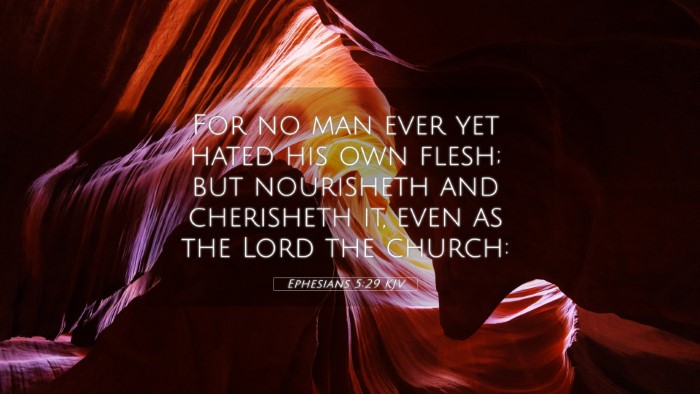Ephesians 5:29 - Bible Verse Meaning and Interpretation
Ephesians 5:29 states: "For no one ever hated his own flesh, but nourishes and cherishes it, just as the Lord does the church."
Summary of Insights
This verse encapsulates the profound relationship between Christ and the Church, drawing a parallel to the natural care one has for their own body. The Apostle Paul highlights love, care, and responsibility, emphasizing the necessity of nurturing relationships.
Commentary Insights
-
Matthew Henry:
Henry points out that just as individuals care for their own bodies, God cares for the Church. It is a model of self-love which leads to self-care and emphasizes that neglecting or harming oneself is contrary to human instinct.
-
Albert Barnes:
Barnes expands on the idea that nourishing and cherishing are expressions of affection. He likens Christ's care for the Church to how one would naturally provide for their own physical body, demonstrating the deep love that Jesus has for believers.
-
Adam Clarke:
Clarke highlights the implications of this verse in relation to marital relationships. Understanding the body as a representation of the Church, there's an encouragement towards husbands to nourish their wives with the same intensity and commitment as Christ does to His church.
Connections Between Bible Verses
This verse is richly connected to various themes and other scriptural texts. Below, we indicate several relevant Bible verses that illuminate the meaning of Ephesians 5:29.
- 1 Corinthians 12:27: "Now you are the body of Christ, and each one of you is a part of it." - This verse stresses the unity and interconnectedness of the Church, paralleling the message of personal care in Ephesians 5:29.
- Colossians 1:18: "He is the head of the body, the church; He is the beginning and the firstborn from among the dead." - Reiterates Christ's role as the caretaker of the Church.
- 1 Peter 5:2: "Be shepherds of God’s flock that is under your care..." - Underlines the responsibility leaders have to care for their communities echoing the nurturing aspect in Ephesians 5:29.
- Romans 12:5: "So in Christ we, though many, form one body, and each member belongs to all the others." - Affirming the communal aspect of nurturing within the body of Christ.
- Ephesians 5:25: "Husbands, love your wives, just as Christ loved the church and gave himself up for her." - Further elaborates on the theme of love and care between husbands and wives as a microcosm of Christ's relationship with the Church.
- John 10:11: "I am the good shepherd. The good shepherd lays down his life for the sheep." - This direct comparison highlights the extent of care and sacrifice that defines the relationship Jesus has with those He leads.
- Matthew 22:39: "And the second is like it: ‘Love your neighbor as yourself.’" - This introduction of neighborly love parallels the self-care mention in Ephesians 5:29 as a foundation for loving others.
Thematic Bible Verse Connections
The broader themes of love, care, and the nature of relationships are pervasive throughout scripture. Authors like Paul often imbue their teachings with reflections on Christ's sacrificial love and the relational responsibilities that emerge from it.
Whether looking at Pauline epistles or other parts of the New Testament, there is a distinct call to emulate Christ’s love through nurturing behavior that manifests in action.
Exploring Cross-Referencing Biblical Texts
Cross-referencing different biblical texts can illuminate deeper meanings found in Ephesians 5:29. Understanding how various scriptures relate allows believers to grasp God’s overarching narrative regarding love, care, and community.
Tools for Bible Cross-Referencing
Utilizing tools such as a bible concordance or a bible cross-reference guide can significantly enhance one's study of scriptures. Here are some effective methods:
- Use of a bible cross-reference system to identify links between similar themes.
- Engagement with cross-reference Bible study resources to delve deeper into specific passages.
- Employing bible reference resources for comprehensive studies of various biblical characters and contexts.
Identifying Connections Between Old and New Testament
How to find cross-references in the Bible can be explored through studying prophetic verses in the Old Testament that foreshadow care and relational themes seen in the New Testament. In the journey of faith, these connections between Old and New Testament texts provide a rich tapestry of understanding God's purpose for humanity.
Conclusion: Embracing the Teachings
In essence, Ephesians 5:29 encourages believers to reflect God’s love through their treatment of one another, illustrating an individual’s responsibility to cultivate nourishing and cherishing relationships. Through diligent study and cross-referencing biblical themes, individuals can discover profound truths intertwined within the tapestry of scripture.











